
Blakeney is a coastal village and civil parish in the English county of Norfolk. Blakeney lies within the Norfolk Coast AONB and the North Norfolk Heritage Coast. The North Norfolk Coastal Path travels along its quayside. The village is 21.1 mi (34 km) north west of Norwich, 4.6 mi (7.4 km) NNW of the larger settlement of Holt, 11.5 mi (18.5 km) west of Cromer and 112 mi (180 km) NNE of London.
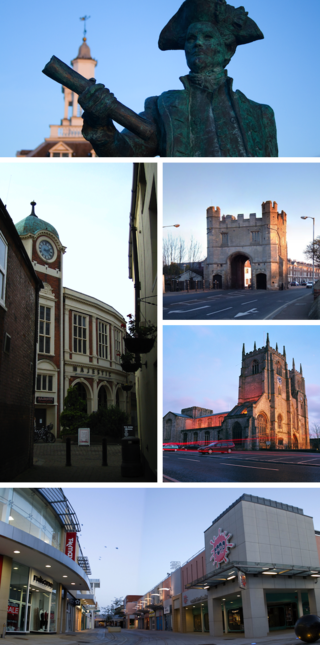
King's Lynn, known until 1537 as Bishop's Lynn and colloquially as Lynn, is a port and market town in the borough of King's Lynn and West Norfolk in the county of Norfolk, England. It is 36 miles (58 km) north-east of Peterborough, 44 miles (71 km) north-north-east of Cambridge and 44 miles (71 km) west of Norwich.

Thetford is a market town and civil parish in the Breckland District of Norfolk, England. It is on the A11 road between Norwich and London, just east of Thetford Forest. The civil parish, covering an area of 29.55 km2 (11.41 sq mi), in 2011 had a population of 24,340.

Norwich Cathedral, formally the Cathedral Church of the Holy and Undivided Trinity, is a Church of England cathedral in the city of Norwich, Norfolk, England. The cathedral is the seat of the bishop of Norwich and the mother church of the diocese of Norwich. It is administered by its dean and chapter, and there are daily Church of England services. It is a Grade I listed building.

Watton is a market town in the Breckland district of Norfolk, England, about 25 miles (40 km) west-southwest of Norwich and 15 miles (24 km) northeast of Thetford. The annual Wayland Agricultural Show in its west is one of the oldest one-day such shows in England.

The Guildhall York is a municipal building located in St Martins Courtyard, Coney Street, in York. Located behind the Mansion House, it is a Grade I listed building.

Portsmouth Guildhall is a multi-use building in the centre of Portsmouth, Hampshire, England. It is located in a pedestrian square close to Portsmouth and Southsea railway station. Constructed in 1890, the building was known as Portsmouth Town Hall until 1926. It was heavily damaged by bombing during the Second World War and largely rebuilt during the 1950s by the English architect Ernest Berry Webber. It now operates as a concert, wedding and conference venue. It is a Grade II listed building.

Norwich City Hall is an Art Deco building completed in 1938 which houses the city hall for the city of Norwich in Norfolk, England. It is one of the Norwich 12, a collection of twelve heritage buildings in Norwich deemed of particular historical and cultural importance. It was designated as a Grade II* listed building in 1971.

The Guildhall is a building on Alfred Gelder Street in the City of Kingston upon Hull, East Riding of Yorkshire, England. The building is currently the headquarters of Hull City Council but is also used as a venue for conferences, civic receptions and formal dinners. It is a Grade II* listed building status.
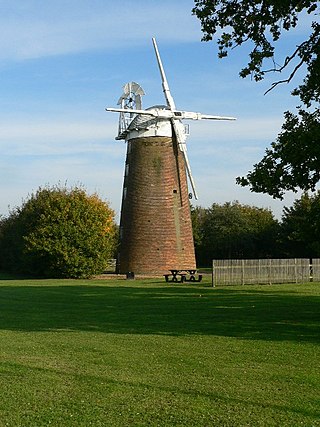
Norwich Road Mill or Fendick's Mill is a Grade II listed tower mill at East Dereham, Norfolk, England which was most recently restored and reopened to visitors in 2013.

Norwich City Council is the local authority for Norwich, a non-metropolitan district with city status in Norfolk, England. It consists of 39 councillors, elected to represent 13 wards, each with three councillors. It forms the lower tier of local government in Norwich, responsible for local services such as housing, planning, leisure and tourism.

Norwich 12 was an initiative by the Norwich Heritage Economic and Regeneration Trust (HERT) to develop 12 of Norwich's most iconic buildings into an integrated family of heritage attractions to act as an international showcase of English urban and cultural development over the last 1,000 years.
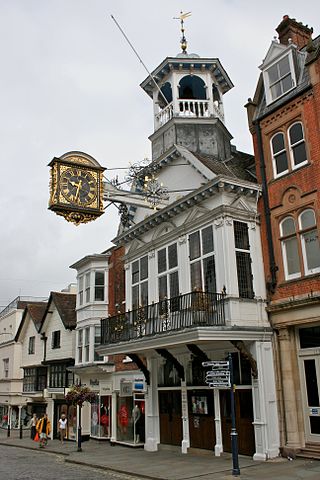
The Guildford Guildhall is a Guildhall located on the High Street of the town of Guildford, Surrey. It is a Grade I listed building.
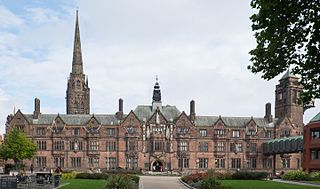
The Council House, Coventry in Coventry, England, is a Tudor Revival style city hall building which is the home of Coventry City Council and the seat of local government. It was built in the early 20th century. It is a Grade II-listed building.

Devonport Guildhall is a municipal building that served as a municipal hall, courthouse, mortuary, and police station, located in the municipal centre of the town of Devonport, in Plymouth, Devon, England. The site fell into disrepair and since the mid-1980s has been repurposed for community facilities. It is a Grade I listed building.

Norwich War Memorial is a First World War memorial in Norwich in Eastern England. It was designed by Sir Edwin Lutyens, the last of his eight cenotaphs to be erected in England. Before Lutyens' involvement, several abandoned proposals had been made for commemorating Norwich's war dead, and by 1926 the newly elected lord mayor was determined to see the construction of a memorial before he left office. He established an appeal to raise funds for local hospitals in memory of the dead as well as a physical monument. He commissioned Lutyens, who designed an empty tomb (cenotaph) atop a low screen wall from which protrudes a Stone of Remembrance. Bronze flambeaux at either end can burn gas to emit a flame. Lutyens also designed a roll of honour, on which the names of the city's dead are listed, which was installed in Norwich Castle in 1931.
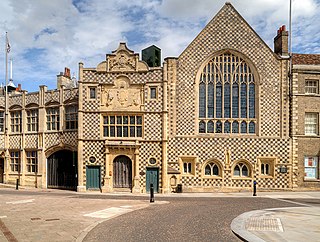
King's Lynn Guildhall, more fully referred to as the Guildhall of the Holy and Undivided Trinity, is a municipal building in Saturday Market Place in King's Lynn, Norfolk. It is a Grade I listed building. The building was substantially extended in 1895, with the whole complex now generally known as King's Lynn Town Hall, with the 1895 extension being separately listed at Grade II. It is the usual meeting place of King's Lynn and West Norfolk Borough Council.

Thetford Guildhall is a municipal structure in the Market Place in Thetford, Norfolk, England. The town hall, which was the headquarters of Thetford Borough Council, is a Grade II listed building.
Henry Woodcock, Esq. (1789–1879) was a prominent 19th century public official in the city of Norwich, Norfolk, United Kingdom. He was elected Sheriff of Norwich for one term (1839), and Mayor of Norwich for two terms and served as commissioner and magistrate.



















